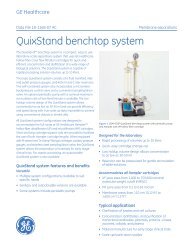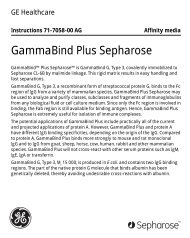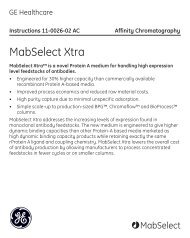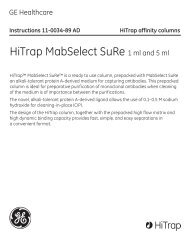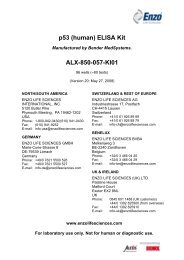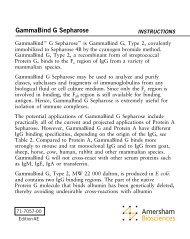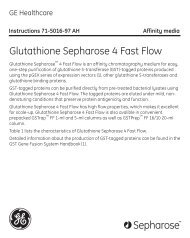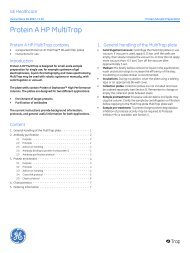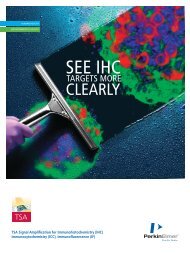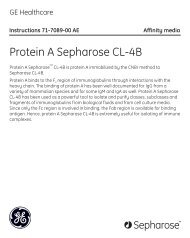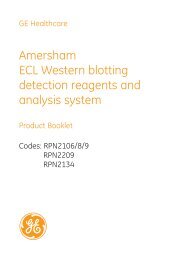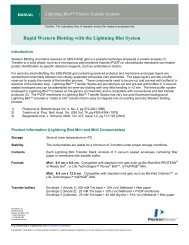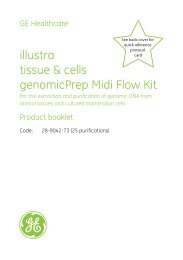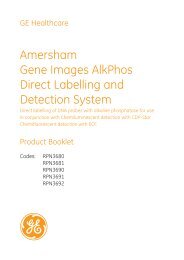HisTrap FF crude Kit
HisTrap FF crude Kit
HisTrap FF crude Kit
- No tags were found...
Create successful ePaper yourself
Turn your PDF publications into a flip-book with our unique Google optimized e-Paper software.
GE Healthcare<br />
Instructions 28-4036-83 AD<br />
Purification of<br />
histidine-tagged proteins<br />
<strong>HisTrap</strong> <strong>FF</strong> <strong>crude</strong> <strong>Kit</strong><br />
<strong>HisTrap</strong> <strong>FF</strong> <strong>crude</strong> <strong>Kit</strong> is a kit for convenient, fast, and efficient purification of<br />
histidine-tagged recombinant proteins. <strong>HisTrap</strong> <strong>FF</strong> <strong>crude</strong> <strong>Kit</strong> contains everything<br />
necessary to perform complete purifications without using complicated equipment.<br />
It also eliminates time-consuming buffer preparation and column packing.<br />
The <strong>HisTrap</strong> <strong>FF</strong> <strong>crude</strong> columns included in the kit are prepacked with Ni Sepharose <br />
6 Fast Flow, a pre-charged IMAC medium with low nickel (Ni 2+ ) ion leakage and<br />
compatibility with a wide range of buffers, reducing agents, denaturants, and<br />
detergents.<br />
The specific design of the column allows direct loading of homogenized unclarified cell<br />
lysate without the need for filtration and/or centrifugation. This decreases the total<br />
purification time that may be important when working with sensitive target proteins.<br />
Caution!<br />
Contains nickel. May produce an allergic reaction.<br />
Code No. Designation No. supplied<br />
28-4014-77 <strong>HisTrap</strong> <strong>FF</strong> <strong>crude</strong> <strong>Kit</strong><br />
containing:<br />
<strong>HisTrap</strong> <strong>FF</strong> <strong>crude</strong> columns<br />
3 × 1 ml<br />
Phosphate buffer, 8x stock solution, pH 7.4 2 × 50 ml<br />
2 M Imidazole, pH 7.4 50 ml<br />
Syringe, 5 ml 1
Connector kit<br />
Connectors supplied Usage No. supplied<br />
1/16” male/luer female Connection of syringe to top of HiTrap column 1<br />
Tubing connector Connection of tubing (e.g. Peristaltic<br />
flangeless/M6 female Pump P1) to bottom of HiTrap column* 1<br />
Tubing connector Connection of tubing (e.g. Peristaltic<br />
flangeless/M6 male Pump P1) to top of HiTrap column † 1<br />
Union 1/16” female/ Connection to original FPLC System<br />
M6 male through bottom of HiTrap column 1<br />
Union M6 female/ Connection to original FPLC System<br />
1/16” male through top of HiTrap column 1<br />
Stop plug female, 1/16” Sealing bottom of HiTrap column 2, 5 or 7<br />
* Union 1/16” female/M6 male is also needed.<br />
†<br />
Union M6 female/1/16” male is also needed.<br />
Table of contents<br />
1. Introduction 3<br />
2. General Considerations 3<br />
3. Sample Preparation 4<br />
4. Protein Purification Protocols 6<br />
5. Column Cleaning and Storage 10<br />
6. Troubleshooting 11<br />
7. Ordering Information 15<br />
Appendix A, Description & characteristics 17<br />
Appendix B, Buffers, Mixing Table 21<br />
p. 2
1. Introduction<br />
<strong>HisTrap</strong> <strong>FF</strong> <strong>crude</strong> <strong>Kit</strong> is designed for rapid, mild affinity purification of<br />
histidine-tagged proteins. Using <strong>HisTrap</strong> <strong>FF</strong> <strong>crude</strong> <strong>Kit</strong>, histidine-tagged<br />
proteins can convenient be prepared to high purity in one step.<br />
Histidine-tagged proteins can be purified directly from unclarified cell<br />
lysates and are recovered from the column under mild elution conditions<br />
that preserve their antigenicity and functionality.<br />
The kit contains three ready to use 1-ml <strong>HisTrap</strong> <strong>FF</strong> <strong>crude</strong> columns (precharged<br />
with Ni 2+ ), buffer concentrates, a 5-ml syringe and connectors.<br />
The kit provides a sufficient volume of buffer concentrates to perform<br />
10–12 purifications when operated with a syringe. The special design of<br />
the column, together with an optimized matrix, provides fast, easy, and<br />
reproducible separations in a convenient format. The possibility for direct<br />
loading of unclarified cell lysates decreases the total purification time and<br />
may increase the possibility to purify sensitive target proteins without losing<br />
their activity.<br />
2. General Considerations<br />
<strong>HisTrap</strong> <strong>FF</strong> <strong>crude</strong> columns are supplied precharged with Ni 2+ ions, and<br />
will selectively retain proteins if complex-forming amino acid residues, in<br />
particular histidine, are exposed on the surface of the protein. Additional<br />
histidines, such as in the case of (histidine) 6 -tag, increases the affinity for<br />
Ni 2+ and generally makes the histidine-tagged protein the strongest binder<br />
among other proteins, in for example an E. coli lysate.<br />
Histidine-tagged proteins can be eluted from <strong>HisTrap</strong> <strong>FF</strong> <strong>crude</strong> with buffers<br />
containing imidazole. Imidazole at low concentrations is commonly used<br />
in the binding and wash buffers to minimize binding of unwanted host cell<br />
proteins. For the same reason it is important to also include imidazole in<br />
the sample (generally, at the same concentration as in the wash buffer). At<br />
somewhat higher concentrations, imidazole may also decrease the binding<br />
of histidine-tagged proteins. The imidazole concentration must therefore<br />
be optimized to ensure the best balance of high purity (low binding of host<br />
cell proteins) and high yield (binding of histidine-tagged target protein). This<br />
p. 3
optimal concentration is different for different histidine-tagged proteins, and<br />
is usually slightly higher for Ni Sepharose 6 Fast low than for similar IMAC<br />
media on the market (see Data File, 11-0008-86, Ni Sepharose 6 Fast Flow.<br />
Use a highly pure imidazole, such as the imidazole provided in the kit; such<br />
imidazole gives essentially no absorbance at 280 nm.<br />
The optimal imidazole concentration can be determined by stepwise<br />
elution of the protein with buffers containing increasing concentrations<br />
of imidazole. Stepwise elution, as described in the Optimization Protocol<br />
on page 8 is technically simple and fast, and is suitable for syringe<br />
operation. The results from this stepwise elution will provide information<br />
on which two imidazole concentrations (wash and elution) are the most<br />
suitable for purifications of identical protein samples. The concentration of<br />
imidazole needed in the sample and the wash buffer to prevent binding of<br />
unwanted host cell proteins is generally more critical to determine than the<br />
concentration needed for elution where 500 mM in most cases can be used<br />
for the latter purpose. When high yield is more important than optimum<br />
purity, the Basic Purification Protocol (see page 6) may be used directly,<br />
without prior optimization.<br />
If the histidine-tagged proteins are expressed as inclusion bodies, see page 12.<br />
3. Sample Preparation<br />
For optimal conditions for growth, induction, and cell lysis of your<br />
recombinant histidine-tagged clones, please refer to established protocols.<br />
The following is a general protocol for sample preparation:<br />
1. Harvest cells from the culture by centrifugation (e.g. by centrifugation at<br />
7 000–8 000 × g for 10 minutes or 1 000–1 500 × g for 30 minutes at 4°C).<br />
2. Discard the supernatant. Place the bacterial pellet on ice.<br />
Recommended four-step protocol for cell lysis<br />
The protocol below has been used successfully in our own laboratories, but<br />
other established procedures may also work.<br />
1. Dilution of cell paste: Add 5–10 ml of binding buffer for each gram of<br />
cell paste. To prevent the binding of host cell proteins with exposed<br />
p. 4
histidines, it is essential to include imidazole at a low concentration<br />
in the sample and binding buffer (see Optimization of purification<br />
performance in section 5).<br />
2. Enzymatic lysis: 0.2 mg/ml lysozyme, 20 μg/ml DNAse, 1 mM MgCl 2 ,<br />
1 mM Pefabloc SC or PMSF (final concentrations). Stir for 30 min at<br />
room temperature or 4°C depending on the sensitivity of the target<br />
protein.<br />
3. Mechanical lysis*: Sonication on ice, approx. 10 min<br />
or<br />
Homogenization with a French press or other<br />
homogenizer<br />
or<br />
Freeze/thaw, repeated at least five times<br />
* Mechanical lysis time may have to be extended compared with standard protocols to<br />
secure an optimized lysate for sample loading (to prevent clogging of the column and back<br />
pressure problems). Different proteins have different sensitivity to cell lysis and caution has<br />
to be taken to avoid frothing and overheating of the sample.<br />
4. Adjust the pH of the lysate: Do not use strong bases or acids for pHadjustment<br />
(precipitation risk). Apply the unclarified lysate on the<br />
column directly after preparation.<br />
Note: If the sonicated or homogenized unclarified cell lysate is frozen<br />
before use, precipitation and aggregation may increase. New<br />
sonication of the lysate can then prevent increased back pressure<br />
problems when loading on the column.<br />
Note: To minimize binding of host cell proteins, the sample should have the<br />
same concentration of imidazole as the binding and wash buffers.<br />
The concentration of imidazole is protein dependent (see General<br />
considerations, page 3).<br />
p. 5
p. 6<br />
4. Protein Purification Protocols<br />
Column preparation<br />
1. Fill the syringe with deionized water. Remove the stopper and connect<br />
the column to the syringe with the provided luer adapter “drop-to-drop”<br />
to avoid introducing air into the column.<br />
2. Remove the snap-off end. Wash the column with 5 ml distilled water.<br />
If air becomes trapped in the column, wash the column with deionized<br />
water until the air disappears.<br />
Note: Leakage of nickel ions from <strong>HisTrap</strong> <strong>FF</strong> <strong>crude</strong> columns is low under all<br />
normal conditions. For very critical applications, the minimal leakage<br />
during purification can be even further diminished by performing a<br />
blank run before loading sample, see below.<br />
Note: Ni Sepharose 6 Fast Flow is compatible with reducing agents (see<br />
Appendix A). However, removal of any weakly bound Ni 2+ ions by<br />
performing a blank run without reducing agents (as described<br />
below), before applying buffer/sample including reducing agents, is<br />
recommended. Do not store <strong>HisTrap</strong> <strong>FF</strong> <strong>crude</strong> columns with buffers<br />
including reducing agents.<br />
Blank run: Use binding and elution buffers without reducing agent.<br />
1. Wash the column with 5 ml of deionized water (to remove the 20%<br />
ethanol).<br />
2. Wash with 5 ml of elution buffer.<br />
3. Equilibrate with 5–10 ml of binding buffer.<br />
Basic Purification Protocol<br />
When high yield is more important than optimum purity, use the following<br />
protocol. When optimum purity is required proceed to the Optimization<br />
Protocol.<br />
1. Prepare 24 ml binding buffer. Mix 3 ml 8 × Phosphate buffer stock<br />
solution with 0.24 ml 2 M imidazole and add water up to 24 ml. Check<br />
pH and adjust to pH 7.4–7.6 if necessary. This buffer will contain 20 mM
phosphate (1×), 500 mM NaCl, and 20 mM imidazole.<br />
2. Prepare 8 ml elution buffer. Mix 1 ml 8 × Phosphate buffer stock solution<br />
with 2 ml 2 M imidazole and add distilled water up to 8 ml. Check pH<br />
and adjust to pH 7.4–7.6 if necessary. This buffer will contain 20 mM<br />
phosphate, 500 mM NaCl, and 500 mM imidazole.<br />
Note: The high salt concentration in the buffer stock solution may cause<br />
salt crystals to form at low temperature. These crystals will dissolve<br />
at room temperature. We therefore recommend that the buffer stock<br />
solutions be allowed to reach room temperature before use. The<br />
formation of salt crystals that dissolve at room temperature does not<br />
affect the performance of the product.<br />
3. Using the syringe, equilibrate the column with 10 ml binding buffer.<br />
4. Apply the unclarified lysate with the syringe. Collect the flowthrough<br />
fraction. A pump (e.g. Peristaltic Pump P-1) is convenient for large<br />
volumes (more than 15 ml) using a flow rate of max. 3 ml/min.<br />
Typical loading volumes of unclarified lysate (highly dependent on<br />
specific sample, sample pretreatment, and temperature at sample<br />
loading): Up to 100 ml.<br />
Note: Sample loading at 4°C may increase the viscosity of the sample. An<br />
adverse effect of increased sample viscosity is that maximum back<br />
pressure for the column is reached at a lower sample volume loading<br />
on the column. Large volumes may increase back pressure, making<br />
the use of a syringe more difficult.<br />
5. Wash with 10 ml binding buffer. Collect the wash fraction.<br />
6. Elute with 5 ml elution buffer. Avoid dilution of the eluate by collecting it<br />
in 1 ml fractions.<br />
7. Check the purification by running an aliquot of the collected samples<br />
on SDS-PAGE. The purified protein is most likely found in the second and<br />
third milliliter of the elution step.<br />
Note: For A 280 nm measurement, use the elution buffer as a blank. If<br />
imidazole needs to be removed use HiTrap Desalting, HiPrep 26/10<br />
Desalting or PD-10 Desalting Columns.<br />
p. 7
8. After the protein has been eluted, regenerate the column by washing it<br />
with binding buffer (according to step 3).<br />
The column is now ready for a new purification. The reuse of<br />
<strong>HisTrap</strong> <strong>FF</strong> <strong>crude</strong> depends on the nature of the sample and should only<br />
be performed with identical histidine-tagged proteins to prevent crosscontamination.<br />
Optimization Protocol<br />
When optimum purity is needed, the following general protocol for stepwise<br />
gradient elution should be used. The next time the same protein is to be<br />
purified, the number of steps can be reduced to those described under the<br />
Basic Protocol with the optimal imidazole concentrations selected here.<br />
1. Prepare buffers according to Table 1.<br />
Table 1. Mixing table for one purification.<br />
Imidazole concen- Phosphate buffer 2 M Imidazole Deionized<br />
tration in buffer 8x stock solution pH 7.4 water<br />
pH 7.4<br />
20 mM 3.0 ml 0.24 ml to 24 ml<br />
40 mM 1.0 ml 0.16 ml to 8 ml<br />
60 mM 1.0 ml 0.24 ml to 8 ml<br />
100 mM 1.0 ml 0.40 ml to 8 ml<br />
300 mM 1.0 ml 1.20 ml to 8 ml<br />
500 mM 1.0 ml 2.00 ml to 8 ml<br />
Use 1 × Phosphate buffer including 20 mM imidazole as binding buffer and<br />
five steps ranging up to 500 mM imidazole as elution buffers. Check pH after<br />
mixing and adjust to pH 7.4–7.6 if necessary. For buffers with closer steps of<br />
imidazole concentrations, and for other volumes, see Appendix B on page 20.<br />
Note: The high salt concentration in the buffer stock solution may cause<br />
salt crystals to form at low temperature. These crystals will dissolve<br />
at room temperature. We therefore recommend that the buffer stock<br />
solutions be allowed to reach room temperature before use. The<br />
formation of salt crystals that dissolve at room temperature does not<br />
affect the performance of the product.<br />
p. 8
2. Wash the column according to Column preparation.<br />
3. Equilibrate the column with 10 ml binding buffer (1× Phosphate buffer,<br />
20 mM imidazole, pH 7.4), using the syringe.<br />
4. Apply the sample. Collect the flowthrough fraction.<br />
5. Wash with 10 ml binding buffer. Collect the wash fraction.<br />
6. Start elution with 5 ml 1× Phosphate buffer containing 40 mM imidazole.<br />
Avoid dilution by collecting the eluate in 1 ml fractions.<br />
7. Proceed with the next imidazole concentration, for example elute with 5<br />
ml<br />
1 × Phosphate buffer containing 60 mM imidazole. Collect the eluate in<br />
1 ml fractions as above.<br />
8. Proceed with the buffers of increasing imidazole concentration, as<br />
described in steps 6 and 7. The purified protein is most likely found in the<br />
second and third milliliter of one of the elution steps.<br />
9. Check the different fractions, for example by SDS-PAGE and/or Western<br />
blotting.<br />
Note: For A 280 measurements, use the elution buffers as blanks. If imidazole<br />
is to be removed, use HiTrap Desalting, HiPrep 26/10 Desalting or<br />
PD-10 Desalting Columns.<br />
10. After the protein has been eluted, re-equilibrate the column with binding<br />
buffer (according to step 3).<br />
The column is now ready for a new purification. The reuse of <strong>HisTrap</strong> <strong>FF</strong> <strong>crude</strong><br />
depends on the nature of the sample and should only be performed with<br />
identical histidine-tagged proteins to prevent cross-contamination.<br />
The results of the above experiment provides information about the optimal<br />
binding and elution buffers. The optimum elution buffer is the one that<br />
eluted the histidine-tagged protein. The optimum binding (wash) buffer is<br />
the one from the step before, with a lower concentration of imidazole. Using<br />
the highest possible concentration of imidazole in the binding buffer will<br />
give the highest purity of the purified protein. Use these buffers for the next<br />
purification of an identical protein. The concentration of imidazole needed<br />
to prevent nonspecific binding of host cell proteins (without any elution of<br />
p. 9
histidine-tagged protein) is generally more important to determine than the<br />
concentration needed for elution. 500 mM can in most cases be used for<br />
elution.<br />
Scaling up<br />
<strong>HisTrap</strong> <strong>FF</strong> <strong>crude</strong> is also available in a 5-ml format, see Ordering Information<br />
on page 15.<br />
Pump operation<br />
The purification process can also be performed using different<br />
chromatography systems, such as ÄKTAdesign , FPLC System or a lowpressure<br />
laboratory pump (e.g. Peristaltic Pump P-1). This would be an<br />
alternative in some situations, for example when large sample volumes<br />
have to be passed through the column. The necessary connectors are listed<br />
below. Connect the column to the pump or chromatography system with<br />
the connectors supplied. Use a flow rate of 1–4 ml/min.<br />
System/ equipment<br />
Syringe<br />
FPLC System<br />
p. 10<br />
ÄKTAdesign systems<br />
Connector<br />
1/16” male/luer female<br />
1/16” female/M6 male and<br />
M6 female/1/16” male<br />
No connector needed<br />
5. Column Cleaning and Storage<br />
Stripping and Cleaning<br />
To remove the Ni 2+ ions prior to cleaning, strip the column with 10 ml 20 mM<br />
sodium phosphate, 500 mM NaCl, 50 mM EDTA, pH 7.4. To remove precipitated<br />
proteins, debris, etc., remove first nickel ions by stripping the column, fill<br />
the column with 1 M NaOH, and incubate for up to 2 hours. Wash out the<br />
dissolved proteins with 10 ml water, and a buffer with pH ~7 until the pH of<br />
the flowthrough reaches pH ~7.<br />
Recharging with nickel ions is done by washing with 10 ml distilled water,<br />
followed by 0.5 ml 0.1 M NiSO 4 (dissolved in distilled water), 5 ml distilled<br />
water, and 5 ml binding buffer (to adjust pH).
Storage<br />
For storage, fill the <strong>HisTrap</strong> <strong>FF</strong> <strong>crude</strong> column with 20% ethanol. Seal<br />
the column with the provided stop plugs to avoid dehydration The<br />
recommended storage temperature for the kit is 4 to 30°C.<br />
6. Troubleshooting<br />
The following tips may be of assistance. If you have any further questions<br />
about the <strong>HisTrap</strong> <strong>FF</strong> <strong>crude</strong> column or the <strong>HisTrap</strong> <strong>FF</strong> <strong>crude</strong> <strong>Kit</strong>, please visit<br />
www.gelifesciences.com/hitrap, contact our technical support or your local<br />
representative.<br />
Note: When using urea or Gua-HCl (as described below), protein unfolding<br />
generally takes place. Refolding on-column (or after elution) is<br />
protein-dependent.<br />
Tips: To minimize dilution of the sample, solid urea or Gua-HCl can be<br />
added.<br />
Tips: Samples containing urea can be analyzed directly by SDS-PAGE<br />
whereas samples containing Gua-HCl must be buffer-exchanged to<br />
a buffer with urea before SDS-PAGE.<br />
Increased back pressure:<br />
• Increase the efficiency of the mechanical cell disruption (for example<br />
increase sonication time). Keep the sample on ice to avoid frothing and<br />
overheating as this may denature the target protein. Over-sonication<br />
can also lead to copurification of host proteins with the target protein.<br />
• Increase dilution of the cell paste before sonication or dilute after the<br />
sonication to reduce viscosity.<br />
• If the lysate is very viscous due to a high concentration of host nucleic<br />
acid, continue sonication until the viscosity is reduced, and/or add an<br />
additional dose of DNAse and Mg 2+ (see Sample preparation, section 3).<br />
Alternatively, draw the lysate through a syringe needle several times.<br />
p. 11
• Freeze/thaw of the unclarified lysate may increase precipitation and<br />
aggregation. Sonication of the thawed lysate can prevent increased<br />
back pressure problems when loading on the column.<br />
• If the purification has been performed at 4°C, move to room temperature<br />
if possible (sample viscosity is reduced at room temperature).<br />
• Decrease flow rate during sample loading.<br />
Column has clogged:<br />
• If cleaning-in-place is unsuccessful, replace the column. Optimize<br />
sample pretreatment before the next sample loading.<br />
Protein is difficult to dissolve or precipitates during<br />
purification:<br />
• The following additives may be used: 2% Triton X-100, 2% Tween 20,<br />
2% NP-40, 2% cholate, 1% CHAPS, 1.5 M NaCl, 50% glycerol, 20 mM<br />
ß-mercaptoethanol, 1–3 mM DTT or DTE (up to 5 mM is possible but<br />
depends on the sample and the sample volume), 5 mM TCEP, 10 mM<br />
reduced glutathione, 8 M urea, or 6 M Gua-HCl. Mix gently for 30 min to<br />
aid solubilization of the tagged protein (inclusion bodies may require<br />
longer mixing). Note that Triton X-100 and NP-40 (but not Tween) have a<br />
high absorbance at 280 nm. Furthermore, detergents cannot be easily<br />
removed by buffer exchange.<br />
• The protein might be insoluble (inclusion bodies): The protein can<br />
usually be solubilized (and unfolded) from inclusion bodies using<br />
common denaturants such as 4–6 M Gua-HCl, 4–8 M urea, or strong<br />
detergents.<br />
Prepare buffers containing 20 mM sodium phosphate, 8 M urea, or<br />
6 M Gua-HCl, and suitable imidazole concentrations, pH 7.4–7.6. Buffers<br />
with urea should also include 500 mM NaCl. Use these buffers for<br />
sample preparation, as well as binding buffer and as elution buffer. For<br />
sample preparation and binding buffer, use 10–20 mM imidazole or<br />
the concentration selected during optimization trials (including urea or<br />
Gua-HCl). To minimize dilution of the sample, solid urea or Gua-HCl can<br />
be added.<br />
p. 12
No histidine-tagged protein in the purified fractions:<br />
• Elution conditions are too mild (histidine-tagged protein still bound):<br />
Elute with an increasing imidazole gradient or decreasing pH to<br />
determine the optimal elution conditions.<br />
• Protein has precipitated in the column: Decrease amount of sample, or<br />
decrease protein concentration by eluting with linear imidazole gradient<br />
instead of imidazole steps. Try detergents or change NaCl concentration,<br />
or elute under denaturing (unfolding) conditions (use 4–8 M urea or<br />
4–6 M Gua-HCl).<br />
• Nonspecific hydrophobic or other interaction: Add a nonionic<br />
detergent to the elution buffer (e.g. 0.2% Triton X-100) or increase the<br />
NaCl concentration.<br />
• Protein found in the flowthrough: Concentration of imidazole in<br />
the sample and/or binding buffer is too high; decrease imidazole<br />
concentration.<br />
• Protein found in the flowthrough: Histidine tag may be insufficiently<br />
exposed; perform purification of unfolded protein in urea or Gua-HCl<br />
as for inclusion bodies. To minimize dilution of the sample, solid urea or<br />
Gua-HCl can be added.<br />
• Protein found in the flowthrough: Buffer/sample composition is not<br />
optimal; check pH and composition of sample and binding buffer. Ensure<br />
that the concentration of chelating or strong reducing agents in the<br />
sample as well as the concentration of imidazole is not too high.<br />
The eluted protein is not pure (multiple bands on<br />
SDS polyacrylamide gel):<br />
• Partial degradation of tagged protein by proteases: Add protease<br />
inhibitors (use EDTA with caution, see Table 2).<br />
• Contaminants have high affinity for nickel ions: Elute with a<br />
stepwise or linear imidazole gradient to determine optimal imidazole<br />
concentrations to use for binding and for wash; add imidazole to<br />
the sample in the same concentration as the binding buffer. Wash<br />
thoroughly before elution with binding buffer containing the highest<br />
p. 13
possible imidazole concentration (chosen imidazole concentration<br />
must not cause elution of the histidine-tagged protein). A shallow<br />
imidazole gradient (20 column volumes or more), may separate proteins<br />
with similar binding strengths. If optimized conditions do not remove<br />
contaminants, further purification by ion exchange chromotography<br />
(HiTrap Q HP or HiTrap SP HP) and/or gel filtration (Superdex Peptide,<br />
Superdex 75, or Superdex 200) may be necessary.<br />
• Contaminants are associated with tagged proteins: Add detergent<br />
and/or reducing agents before sonicating cells. Increase detergent levels<br />
(e.g. up to 2% Triton X-100 or 2% Tween 20), or add glycerol (up to 50%)<br />
to the wash buffer to disrupt nonspecific interactions.<br />
Histidine-tagged protein is eluted during sample<br />
loading/wash:<br />
• Buffer/sample composition is not optimal: Check pH and composition<br />
of sample and binding buffer. Ensure that the concentration of chelating<br />
or strong reducing agents in the sample, as well as the concentration of<br />
imidazole is not too high.<br />
• Histidine tag is partially obstructed: Purify under denaturing<br />
conditions (use 4–8 M urea or 4–6 M Gua-HCl).<br />
• Column capacity is exceeded: If <strong>HisTrap</strong> <strong>FF</strong> <strong>crude</strong> 1-ml columns have<br />
been used, change to a larger column, <strong>HisTrap</strong> <strong>FF</strong> <strong>crude</strong> 5 ml.<br />
p. 14
7. Ordering Information<br />
Product No. Supplied Code No.<br />
<strong>HisTrap</strong> <strong>FF</strong> <strong>crude</strong> <strong>Kit</strong> 1 kit 28-4014-77<br />
Related products No. Supplied Code No.<br />
<strong>HisTrap</strong> <strong>FF</strong> <strong>crude</strong> 5 × 1 ml 11-0004-58<br />
<strong>HisTrap</strong> <strong>FF</strong> <strong>crude</strong> 100 × 1 ml * 11-0004-59<br />
<strong>HisTrap</strong> <strong>FF</strong> <strong>crude</strong> 5 × 5 ml 17-5286-01<br />
<strong>HisTrap</strong> <strong>FF</strong> <strong>crude</strong> 100 × 5 ml * 17-5286-02<br />
HiTrap Desalting 5 × 5 ml 17-1408-01<br />
HiPrep 26/10 Desalting 1 × 53 ml 17-5087-01<br />
HiPrep 26/10 Desalting 4 × 53 ml 17-5087-02<br />
PD-10 Desalting Column 30 17-0851-01<br />
* Special pack size delivered on specific customer order.<br />
Accessories No. Supplied Code No.<br />
1/16” male/luer female* 2 18-1112-51<br />
Tubing connector flangeless/M6 female* 2 18-1003-68<br />
Tubing connector flangeless/M6 male* 2 18-1017-98<br />
Union 1/16” female/M6 male* 6 18-1112-57<br />
Union M6 female /1/16” male* 5 18-3858-01<br />
Union luerlock female/M6 female 2 18-1027-12<br />
HiTrap/HiPrep, 1/16” male connector for ÄKTAdesign 8 28-4010-81<br />
Stop plug female, 1/16” † 5 11-0004-64<br />
Fingertight stop plug, 1/16” ‡ 5 11-0003-55<br />
* One connector included in each HiTrap package.<br />
† Two, five, or seven stop plugs female included in HiTrap packages depending on the product.<br />
‡ One fingertight stop plug is connected to the top of each HiTrap column at delivery.<br />
p. 15
Related literature<br />
Code No.<br />
Recombinant Protein Purification Handbook,<br />
Methods and Principles 18-1142-75<br />
Affinity Chromatography Handbook,<br />
Principles & Methods 18-1022-29<br />
Convenient Protein Purification,<br />
HiTrap Column Guide 18-1129-81<br />
Affinity Chromatography Columns and Media,<br />
Selection guide 18-1121-86<br />
p. 16
Appendix A<br />
Description & characteristics<br />
Medium<br />
<strong>HisTrap</strong> <strong>FF</strong> <strong>crude</strong> is packed with Ni Sepharose 6 Fast Flow.<br />
Ni Sepharose 6 Fast Flow consists of 90 µm particles of highly crosslinked<br />
agarose to which Ni 2+ ions are bound by a stable chelating group.<br />
This coupling technique gives negligible metal-ion leakage, high binding<br />
capacity, and high performance. The medium is compatible with all<br />
commonly used aqueous buffers and denaturants, such as 6 M Gua-HCl,<br />
and 8 M urea. EDTA, EGTA, and other strong chelators should be used with<br />
caution during purification (see Table 2). The medium is optimized for<br />
purification of histidine-tagged proteins.<br />
Column<br />
The column is made of polypropylene, which does not interact with<br />
biomolecules. Each column is delivered with a stop plug on the inlet and<br />
a snap-off end on the outlet. The columns have porous top and bottom<br />
frits that allow high flow rates. Separations can be easily performed using<br />
the syringe supplied or alternatively, a low pressure laboratory pump, for<br />
example Peristaltic Pump P-1 or an ÄKTAdesign chromatography system.<br />
The column cannot be opened or refilled.<br />
Note: To prevent leakage it is essential to ensure that the<br />
adapter is tight.<br />
p. 17
Table 2. Characteristics of <strong>HisTrap</strong> <strong>FF</strong> <strong>crude</strong> 1 ml.<br />
Matrix Highly cross-linked spherical agrose, 6%<br />
Column volume<br />
1 ml<br />
Column dimensions 0.7 × 2.5 cm<br />
Dynamic binding capacity* At least 40 mg (histidine) 6 -tagged protein per<br />
column<br />
Average particle size 90 µm<br />
Pre-charged metal ion Ni 2+<br />
Maximum flow rate 4 ml/min<br />
Recommended flow rate 1–4 ml/min<br />
Maximum back pressure† 0.3 MPa, 3 bar<br />
Compatibility during use Stable in all commonly used aqueous buffers,<br />
reducing agents and denaturants. See Table 3.<br />
Chemical stability ‡<br />
0.01 M HCl, 0.1 M NaOH. Tested for 1 week at 40°C.<br />
1 M NaOH, 70% acetic acid. Tested for 12 hours.<br />
2% SDS. Tested for 1 hour.<br />
30% 2-propanol. Tested for 30 minutes.<br />
pH stability ‡<br />
Short term (< 2 hours) 2 to 14<br />
Long term (< 1 week) 3 to 12<br />
Storage<br />
4°C to 30°C in 20% ethanol (antimicrobial agent)<br />
Avoid<br />
Chelating agents e.g. EDTA, EGTA, citrate<br />
* Dynamic binding capacity conditions:<br />
Sample:<br />
1 mg/ml (histidine) 6 -tagged pure protein (M r 28 000 or 43 000) in binding<br />
buffer (QB 10 %-determination) or protein bound from E. coli extracts<br />
Column volume: 1 ml<br />
Flow rate:<br />
1 ml/min<br />
Binding buffer: 20 mM sodium phosphate, 500 mM NaCl, 5 mM imidazole, pH 7.4<br />
Elution buffer: 20 mM sodium phosphate, 500 mM NaCl, 500 mM imidazole, pH 7.4<br />
Note:<br />
Dynamic binding capacity is protein-dependent<br />
† H 2 O at room temperature.<br />
‡ Ni 2+ -stripped medium.<br />
p. 18
Buffers<br />
The phosphate buffer and the imidazole solution included in <strong>HisTrap</strong> <strong>FF</strong> <strong>crude</strong><br />
<strong>Kit</strong> have been prepared using the highest quality salts and water and filtered<br />
through a 0.45 µm filter.<br />
Note: The high salt concentration in the buffer stock solution may cause<br />
salt crystals to form at low temperature. These crystals will dissolve<br />
at room temperature. We therefore recommend that the buffer stock<br />
solutions be allowed to reach room temperature before use. The<br />
formation of salt crystals that dissolve at room temperature does not<br />
affect the performance of the product.<br />
Denaturing conditions<br />
The buffers described above refer to native conditions. For denaturing<br />
conditions use 20 mM sodium phosphate, 8 M urea or 6 M Gua-HCl and<br />
imidazole concentrations in the range 10 mM–500 mM, pH 7.4. Buffers with<br />
urea should also contain 500 mM NaCl.<br />
Buffers recipes<br />
If larger volumes of solutions are needed than supplied in the kit they can be<br />
prepared as follows:<br />
• 8 × Phosphate buffer, pH 7.4<br />
To 1.42 g Na 2 HPO 4 × 2H 2 O (177.99 g/mol), 1.11 g NaH 2 PO 4 × H 2 O (137.99<br />
g/mol), and 23.38 g NaCl (58.44 g/mol), add distilled water to 90 ml and<br />
dissolve completely. Adjust the pH to 7.4. Add distilled water to 100 ml<br />
and filter through a 0.45 µm filter.<br />
This gives a final concentration of 160 mM phosphate and 4 M NaCl.<br />
• 2 M Imidazole, pH 7.4<br />
To 13.62 g imidazole (68.08 g/mol) add distilled water to 90 ml and<br />
dissolve completely. Adjust the pH to 7.4 using conc. HCl. Add distilled<br />
water to 100 ml and filter through a 0.45 µm filter. Use a highly pure<br />
imidazole, that has essentially no absorbance at 280 nm.<br />
p. 19
Table 3. Ni Sepharose 6 Fast Flow is compatible with the following<br />
compounds, at least at the concentrations given.<br />
Reducing agents*<br />
5 mM DTE<br />
5 mM DTT<br />
20 mM ß-mercaptoethanol<br />
5 mM TCEP<br />
10 mM reduced glutathione<br />
Denaturing agents 8 M urea †<br />
6 M guanidine hydrochloride †<br />
Detergents<br />
2% Triton X-100 (non-ionic)<br />
2% Tween 20 (non-ionic)<br />
2% NP-40 (non-ionic)<br />
2% cholate (anionic)<br />
1% CHAPS (zwitterionic)<br />
Additives<br />
500 mM imidazole<br />
20% ethanol<br />
50% glycerol<br />
100 mM Na 2 SO 4<br />
1.5 M NaCl<br />
1 mM EDTA ‡<br />
60 mM citrate ‡<br />
Buffer substances 50 mM sodium phosphate, pH 7.4<br />
100 mM Tris-HCl, pH 7.4<br />
100 mM Tris-acetate, pH 7.4<br />
100 mM HEPES, pH 7.4<br />
100 mM MOPS, pH 7.4<br />
100 mM sodium acetate, pH 4 †<br />
* See notes and blank run, page 6.<br />
† Tested for 1 week at 40°C.<br />
‡ The strong chelator EDTA has been used successfully in some cases, at 1 mM. Generally,<br />
chelating agents should be used with caution (and only in the sample, not the buffers). Any<br />
metal ion stripping may be counteracted by addition of a small excess of MgCl 2 . Note that<br />
stripping effects may vary with applied sample volume.<br />
p. 20
Appendix B<br />
Buffers, Mixing Table for 50 ml Buffer<br />
Imidazole concen- Phosphate buffer 8x 2 M Imidazole Deionized<br />
tration in buffer stock solution pH 7.4 pH 7.4 water<br />
mM ml ml ml<br />
0 6.25 0 to 50 ml<br />
10 6.25 0.25 to 50 ml<br />
20 6.25 0.50 to 50 ml<br />
30 6.25 0.75 to 50 ml<br />
40 6.25 1.00 to 50 ml<br />
50 6.25 1.25 to 50 ml<br />
60 6.25 1.50 to 50 ml<br />
70 6.25 1.75 to 50 ml<br />
80 6.25 2.00 to 50 ml<br />
90 6.25 2.25 to 50 ml<br />
100 6.25 2.50 to 50 ml<br />
150 6.25 3.75 to 50 ml<br />
200 6.25 5.00 to 50 ml<br />
250 6.25 6.25 to 50 ml<br />
300 6.25 7.50 to 50 ml<br />
400 6.25 10.00 to 50 ml<br />
500 6.25 12.50 to 50 ml<br />
To obtain the imidazole concentration indicated in the first column, mix Phosphate<br />
buffer 8 × stock solution, 2 M imidazole and distilled water according to the table.<br />
Check pH and adjust to pH 7.4–7.6 if necessary. These buffers will contain 20 mM<br />
phosphate, 500 mM NaCl, and the concentrations of imidazole indicated. For<br />
one purification, 24 ml of the binding buffer and 8 ml of each elution buffer are<br />
sufficient.<br />
p. 21
www.gelifesciences.com/hitrap<br />
GE Healthcare Bio-Sciences AB<br />
Björkgatan 30<br />
751 84 Uppsala<br />
Sweden<br />
GE Healthcare UK Limited<br />
Amersham Place<br />
Little Chalfont<br />
Buckinghamshire, HP7 9NA<br />
UK<br />
GE Healthcare Europe, GmbH<br />
Munzinger Strasse 5<br />
D-79111 Freiburg<br />
Germany<br />
GE Healthcare Bio-Sciences Corp<br />
800 Centennial Avenue, P.O. Box 1327<br />
Piscataway, NJ 08855-1327<br />
USA<br />
GE Healthcare Bio-Sciences KK<br />
Sanken Bldg., 3-25-1, Hyakunincho<br />
Shinjuku-ku, Tokyo 169-0073<br />
Japan<br />
GE, imagination at work and GE monogram are trademarks of General Electric Company.<br />
<strong>HisTrap</strong>, HiTrap, HiPrep, ÄKTAdesign, FPLC, Superdex, Sepharose and Drop Design are trademarks of GE Healthcare<br />
companies.<br />
IMAC Sepharose products, Ni Sepharose products and Fe Sepharose products are covered by US pat No 6 623 655 and their<br />
equivalents in other countries.<br />
Purification and preparation of fusion proteins and affinity peptides comprising at least two adjacent histidine residues may<br />
require a license under US pat 5,284,933 and US pat 5,310,663, including corresponding foreign patents (assigne: Hoffman<br />
La Roche, Inc).<br />
All third party trademarks are the property of their respective owners.<br />
© 2006–2008 General Electric Company – All rights reserved.<br />
First published Nov. 2006<br />
All goods and services are sold subject to the terms and conditions of sale of the company within GE Healthcare which<br />
supplies them. GE Healthcare reserves the right, subject to any regulatory and contractual approval, if required, to make<br />
changes in specifications and features shown herein, or discontinue the product described at any time without notice or<br />
obligation. Contact your local GE Healthcare representative for the most current information.<br />
28-4036-83 AD 02/2008



